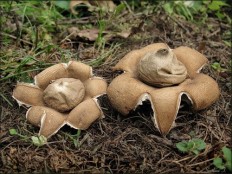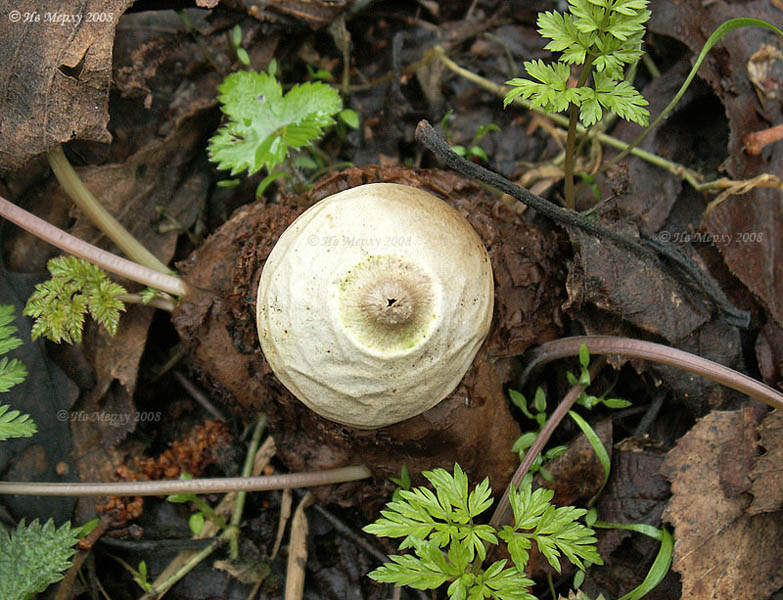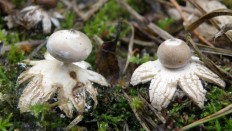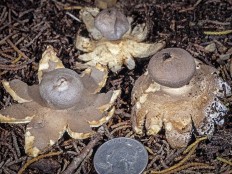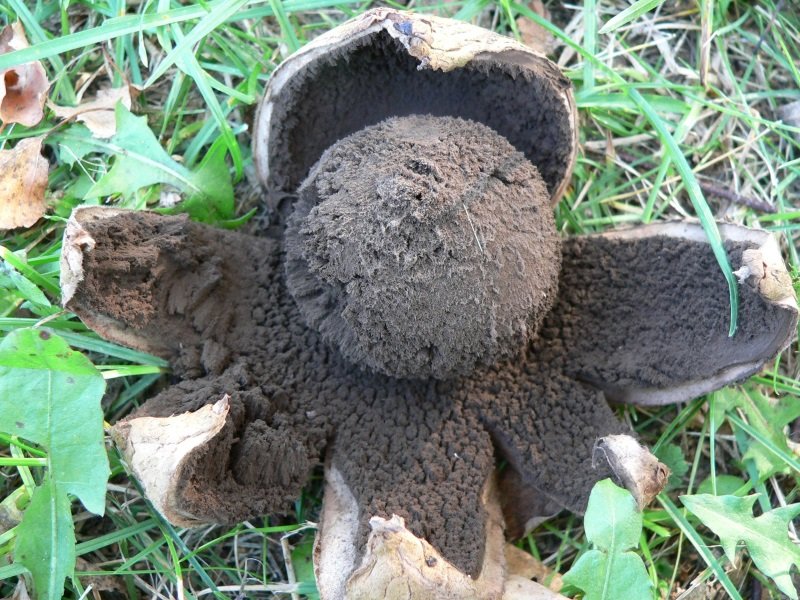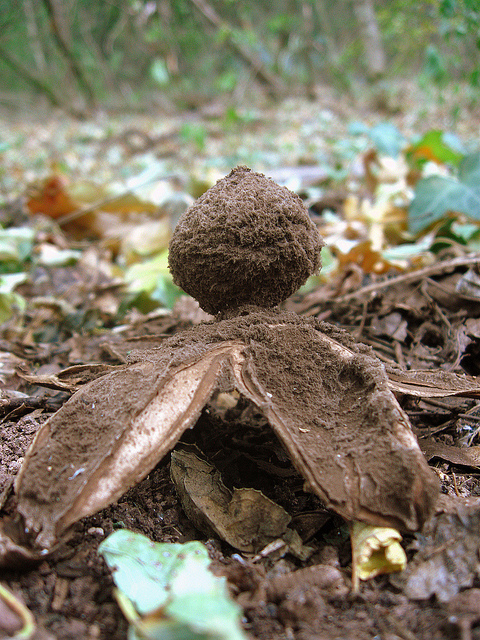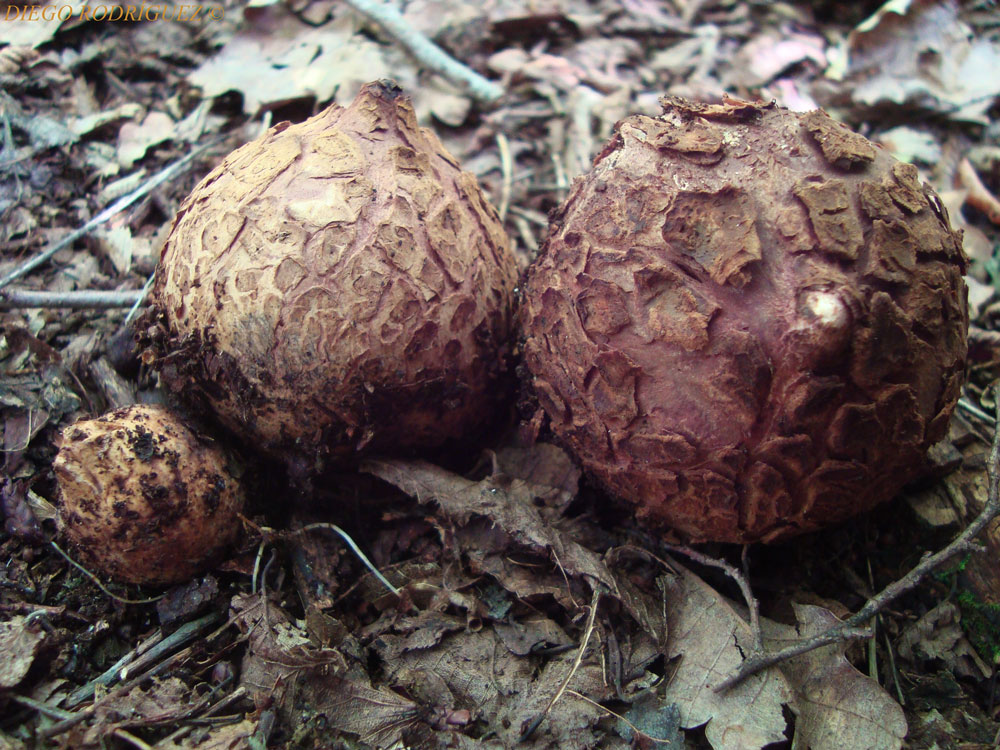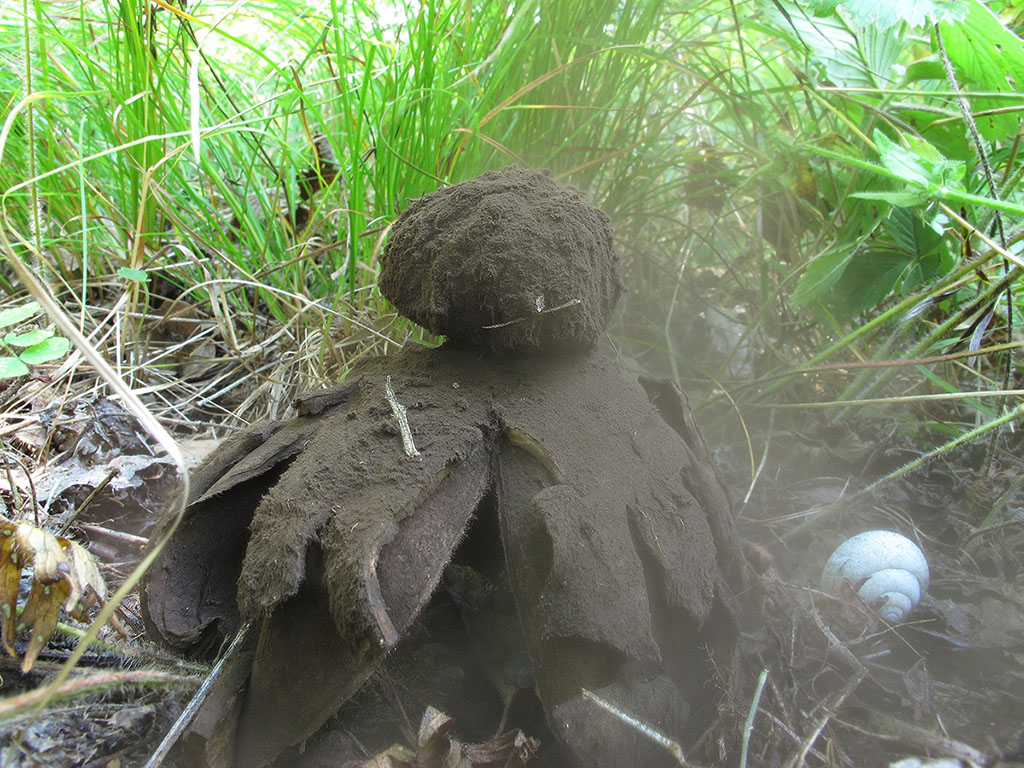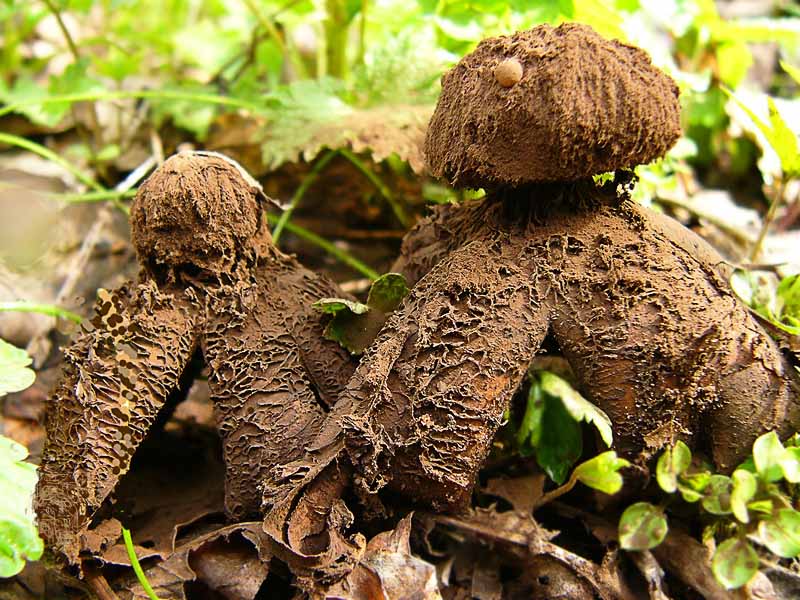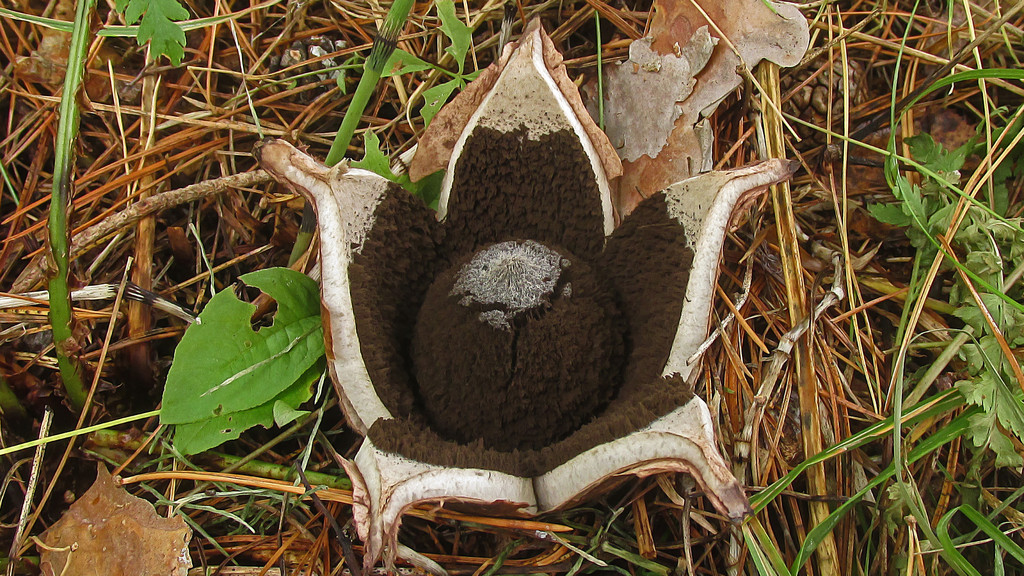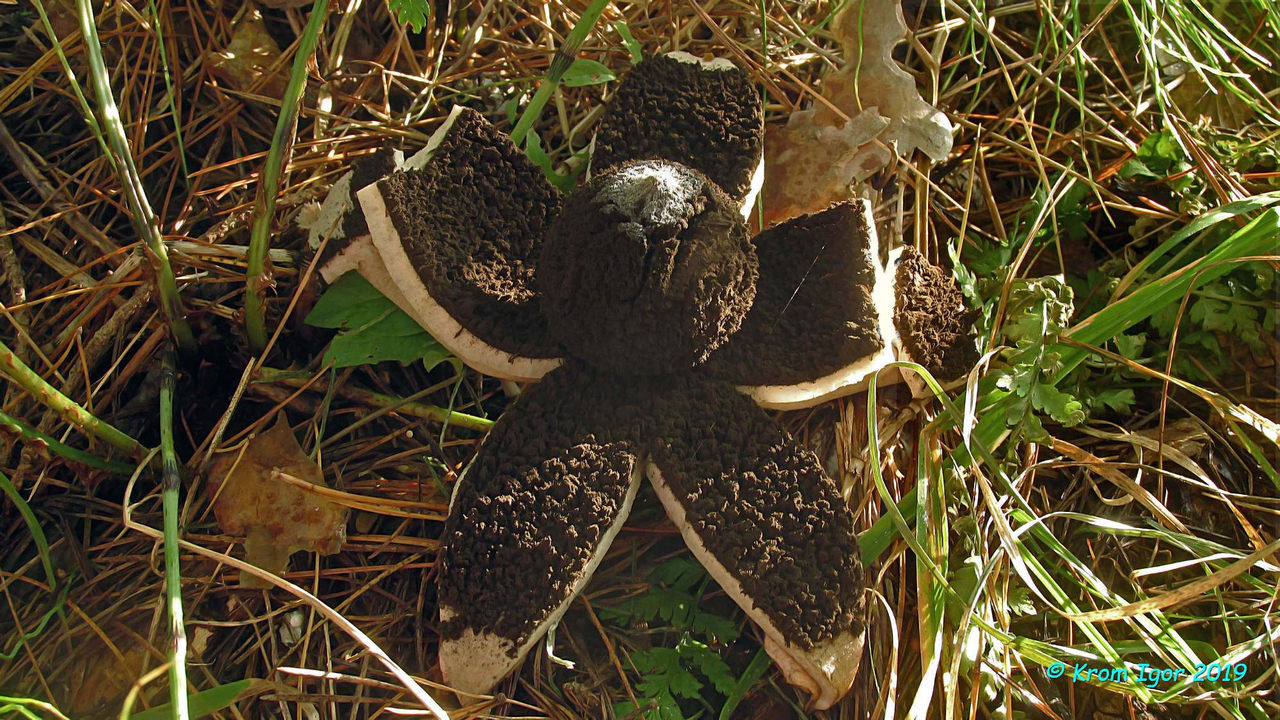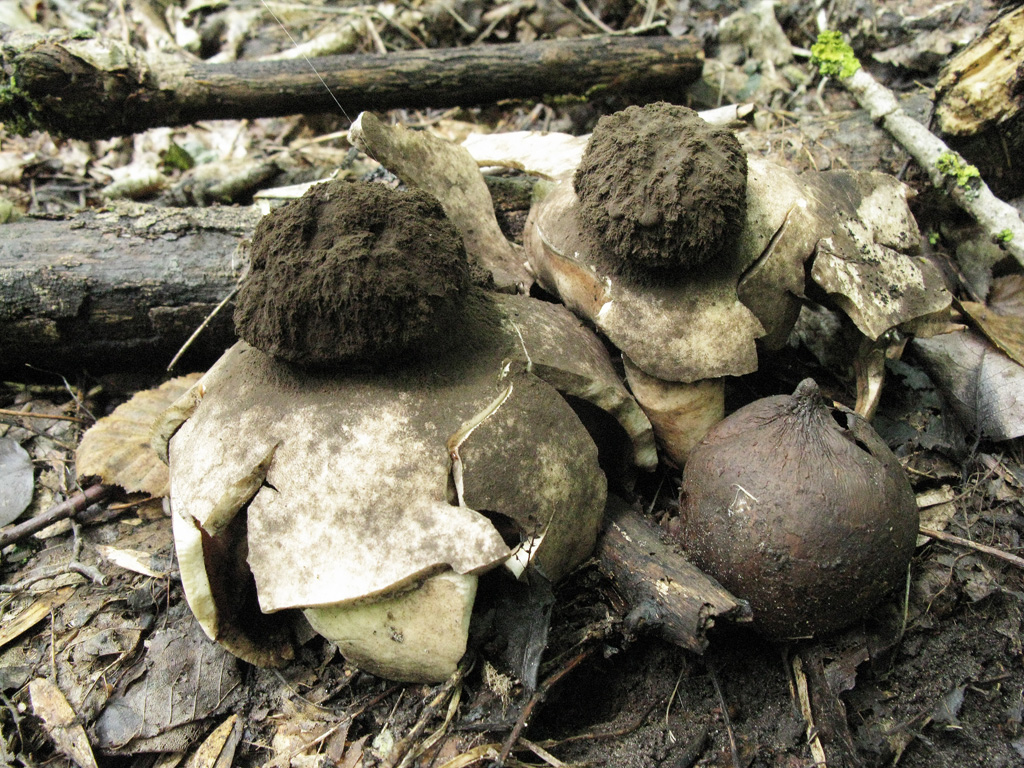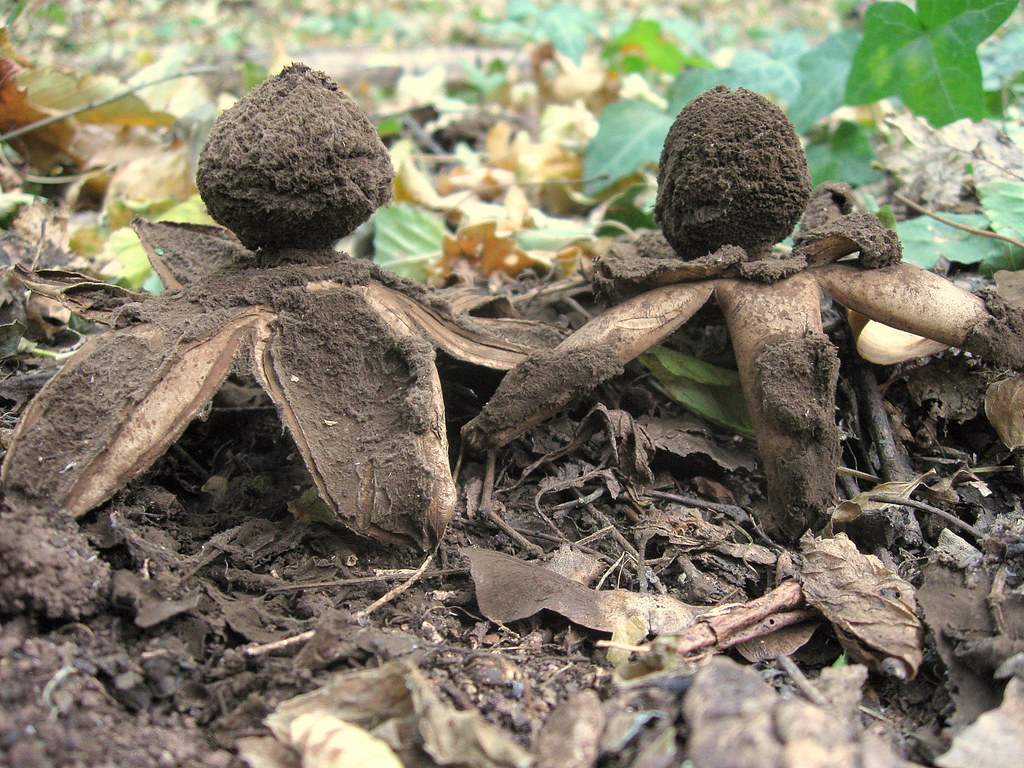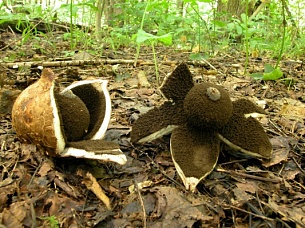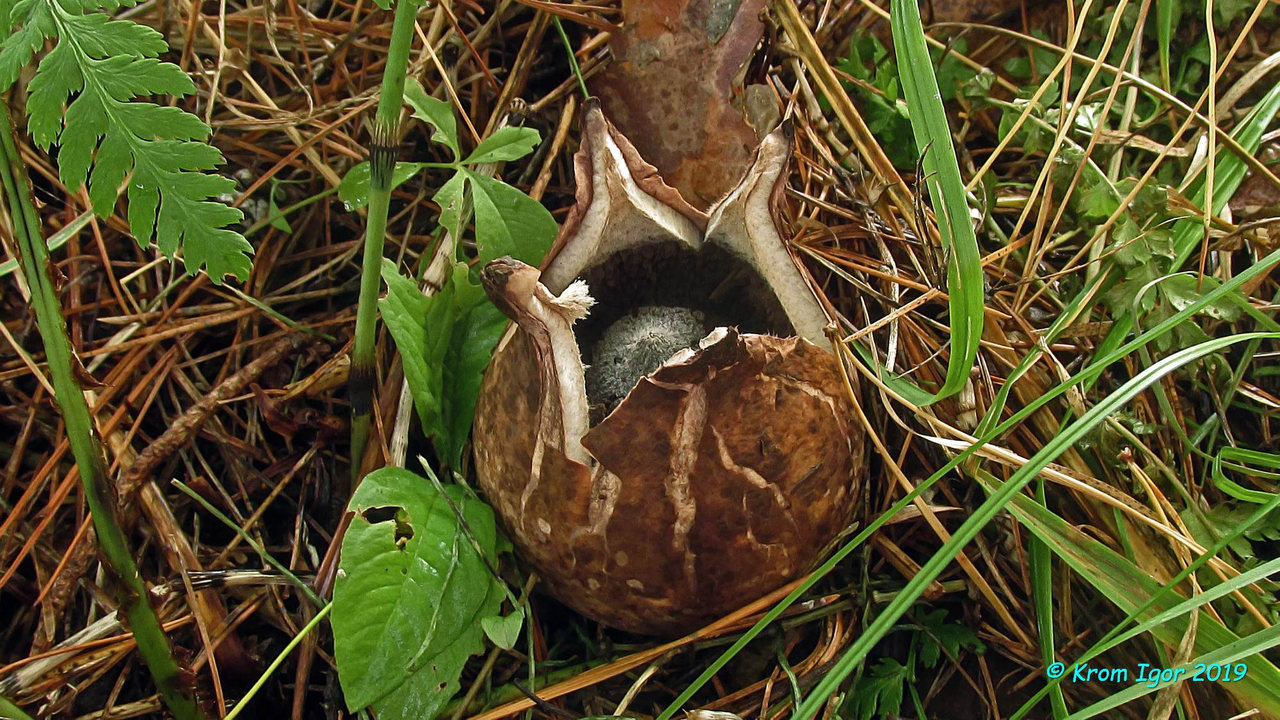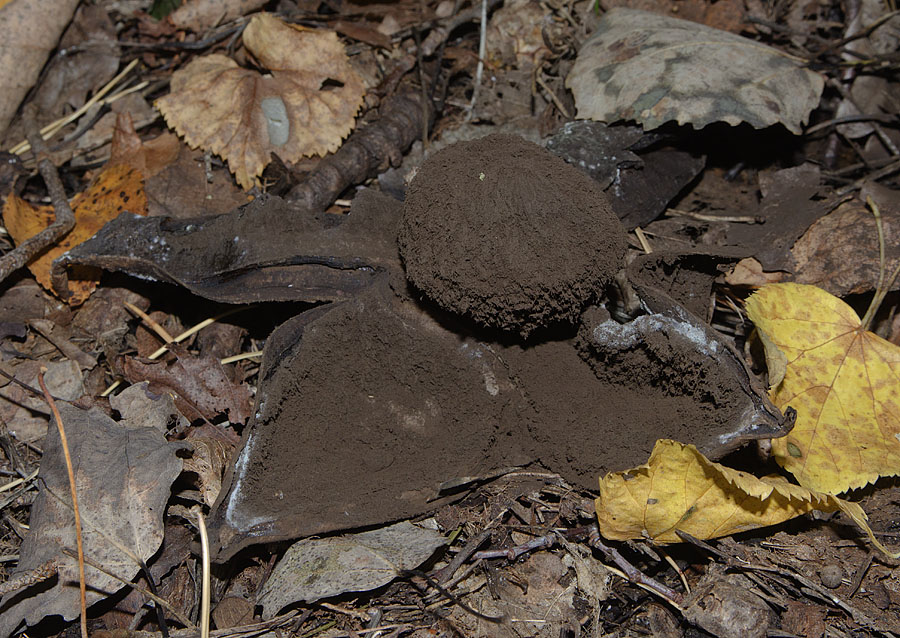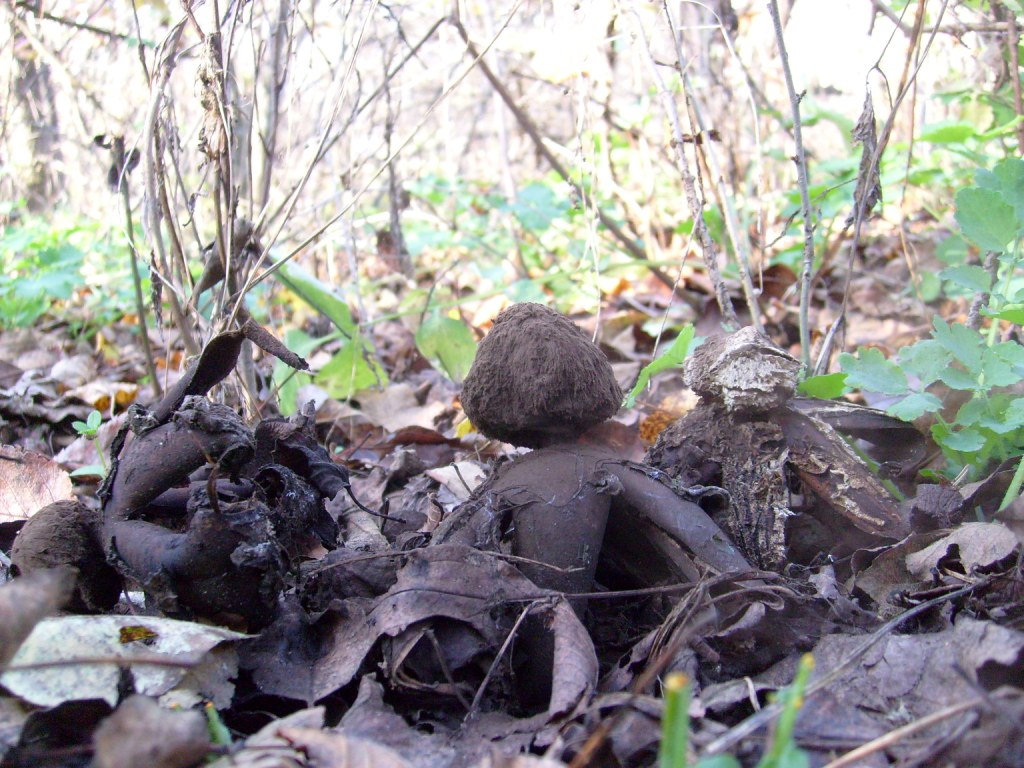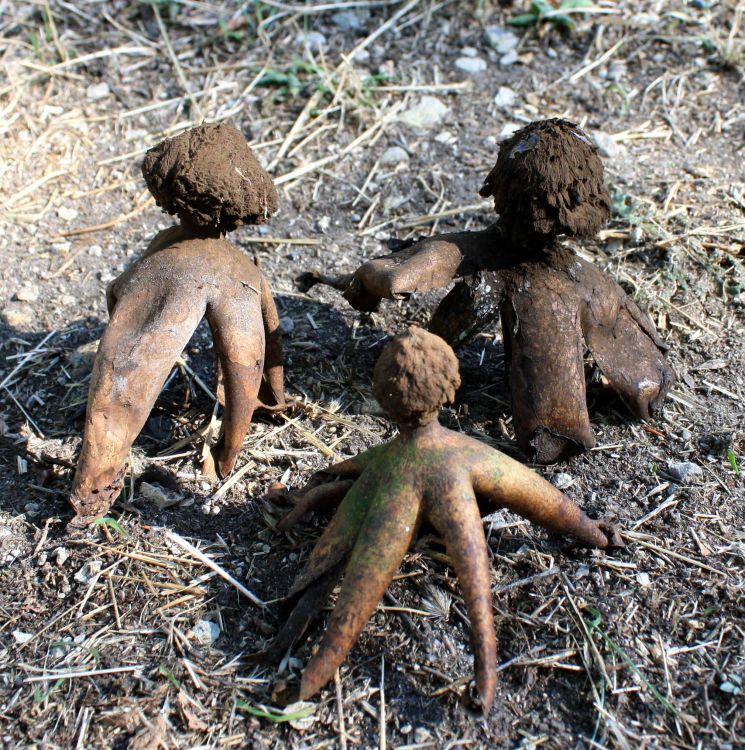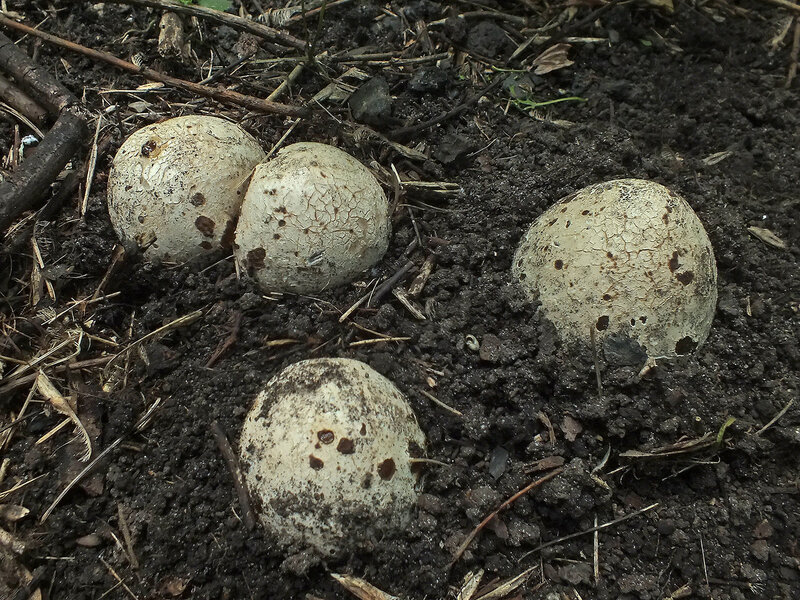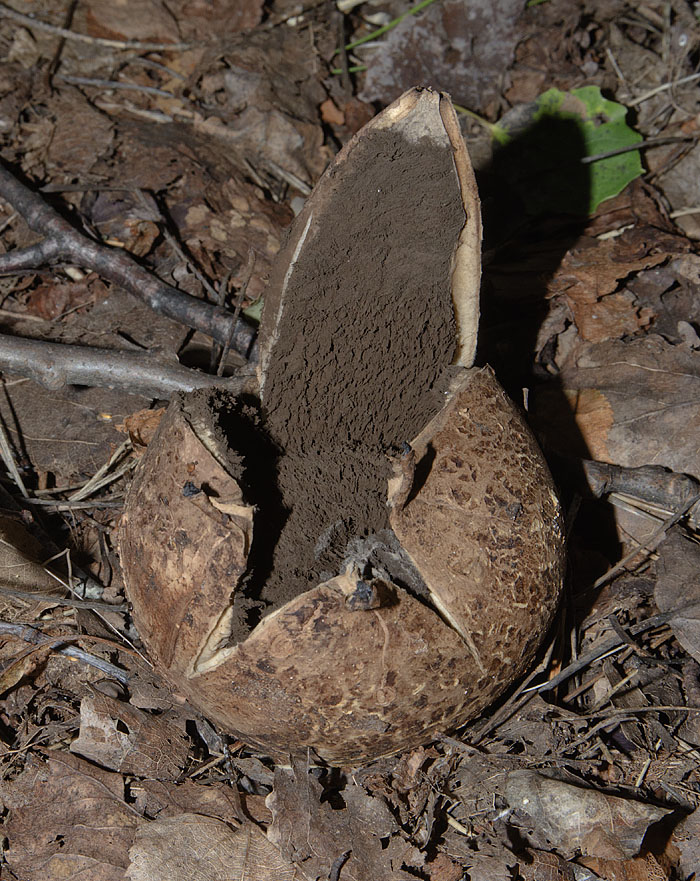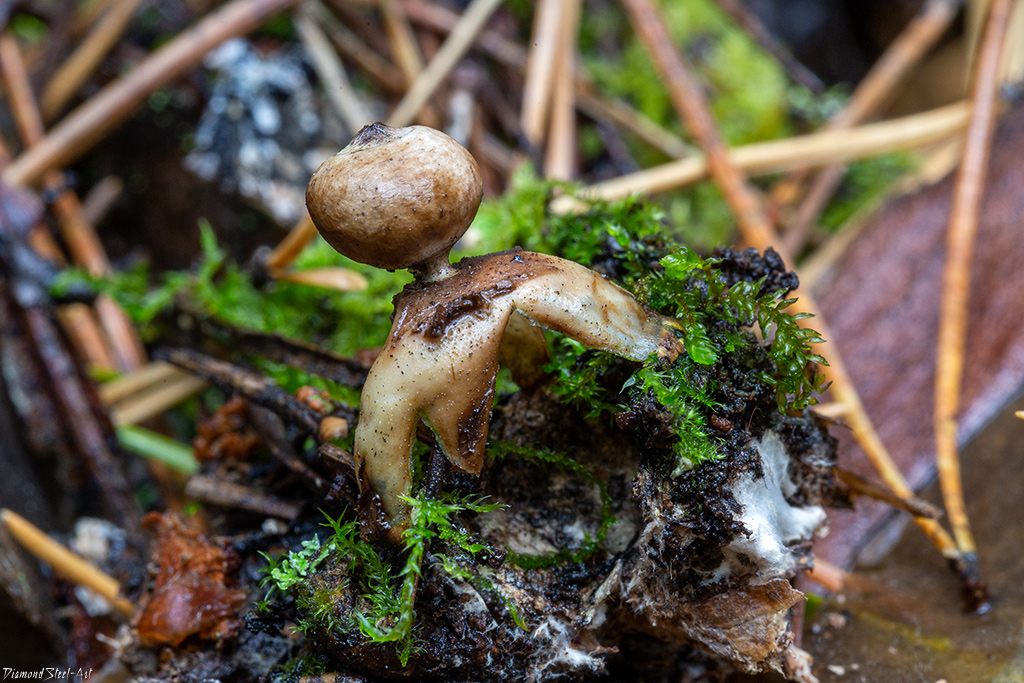Mushroom species
Starfish species are divided into 2 main groups. Some mushrooms are eaten at a young age, while others are not suitable for cooking. Old eukaryotes of any kind do not eat: they lose their attractiveness, become hard and tasteless, but they have other beneficial properties.
Inedible starfish species
Geastrooms are mostly non-edible, although they have interesting external features. They do not belong to poisonous mushrooms either. Inedible starfish are used in folk medicine. They have several types with their own characteristics:
- The star is triple: in its appearance, it has features that somewhat distinguish it from its fellows. It has a double layer of the outer shell (peridium), the upper part of which bursts into several unequal parts, and the inner one forms a bowl around the spore-bearing body. On the upper part of the spherical bag with spores, a kind of belt is formed, called a courtyard. The color of the mushroom body can become beige or light brown.
- Starfish striped: the young fruiting body is located underground and resembles a bulb in shape. As it matures, the body of the fungus spreads out long, creamy, star-shaped blades that crack and darken over time. The spore body has a small diameter, elongated shape, sits on a small thick stalk. It has a gray color, covered with a whitish bloom, the tip at the top is characterized by pronounced stripes, which is where the name of the species comes from. The main difference of the species is the location of the mycelium - on the soil surface, and as it is "accepted" - in the soil.
- Starfish crowned: has gray dull lobes on the outer shell of the mushroom body. The spore-bearing part rises on an elongated neck. But the leg is missing. The color of the ball is much darker than the star-like part of the geastrum, more like a brown tint.
- Fringed starfish: partially reveals its fruiting body from the ground. The outer shell (of the side) has a yellowish-brown tint, breaks into 5-7 lobes, which are strongly curved downward. The spore-bearing ball is gray in color and has a poorly defined courtyard. When looking from above at the organism of the fungus, one can clearly see at the edges of the blades a kind of denser fringe formed from the upper layer of the peridium.
- Small starfish: this species is called the smallest representative of the Geastrov family. The lobes of the upper layer of the mushroom body crack into 8-12 equal parts in the horizontal plane, then the mushroom body rises slightly. The color scheme of the star's petals is closer to beige-gray; over time, cracks appear with a lighter inner content. A spore-bearing gray ball becomes brown closer to ripening, the proboscis elongates at the apex. Interestingly, the endoperidium (inner layer of the shell) is characterized by the presence of a kind of crystalline coating.
- Black-headed starfish: is a special species. Its appearance in youth and maturity can be said to be strikingly different. When the mushroom body is still young, it resembles an ordinary light or slightly brownish raincoat. As it matures, the outer shell bursts into 5-8 parts, exposing the spore-bearing ball. The inner part of the star's rays and the top itself are covered with a rather thick layer of dark, often black, mature spores, which are immediately carried away by wind and rain.
- Four-lobed starfish: during the ripening and blooming of the "petals" it also raises the body above the ground. The color of the outer layer is gray-white, and the spore-bearing ball is dark gray.A special feature of the eukaryote is a pronounced flattened rim around the hole at the top of the ball - a courtyard.
Conditionally edible mushrooms
Only young mushrooms are suitable for consumption.
Young mushrooms from the Geastrov family are eaten as an exotic supplement. These species are few in number. In a state of physiological maturity, mushrooms are no longer suitable for human consumption.
Vaulted starfish: This is one of the rarest species, characterized by a flattened or spherical underground body. When the upper layer is separated, ingrown fragments of litter remain on the visible side of the blades, which create the appearance of cascades and canopies. The color of the outer part is brown, the spore-bearing ball is flattened, fawn, matte.
Mushroom application
The benefits of earthen stars are closely related to their use. They do not have any toxic substances, they are similar to raincoats. They are rarely used for food: they do not have a pronounced taste or smell. Previously, such mushrooms are not boiled.
In folk medicine, the star and its controversy are more popular. They found practical applications:
- the body of a young starfish, cut into plates, replaces the plaster and dressings, because it successfully stops blood and is able to help the speedy regeneration of the wound;
- a powder is made from mature spores, it is also added to medicinal tinctures;
- geastrum, or starfish, are rich in chemical components, therefore extracts from them are used as antiseptics and antineoplastic agents.
Rare earthen star mushroom
An earthen star mushroom in the forest near Ogre.
Mushrooms Earth Star - The most beautiful and rare mushrooms. Veselki.
Inedible species
The star family are mostly inedible species of mushrooms, at the same time they are not poisonous. Often, representatives of this family are used in traditional medicine.
- The triple earthen star is a mushroom slightly different from related species, which is characterized by a double layer of the outer shell. When ripe, the surface bursts into pieces, forming an unequal number of rays, and the inner one turns into a kind of border framing the spore-bearing body, thus forming a bowl. The color of the mushroom body is from light beige to brownish.
- Striped starfish - as well as the form described above, has characteristic differences. The mycelium of this type of mushroom is located not like most representatives of this family - under the surface of the earth, but above it. As the specimens mature, the fruiting body forms long, creamy rays that give the mushroom the shape of a star. Over time, these rays crack and darken significantly. An elongated spore-bearing body of small size is located on a small and rather powerful stalk. Differs in a characteristic gray color with a light bloom. The central part is divided by stripes.
- Fringed starlet is a mushroom whose fruit body is partially hidden under the ground. The outer shell of a brownish tint, as a rule, bursts into 6-7 parts bent to the bottom. The sphere with spores is gray; there is a weakly outlined bowl (courtyard) bordering it.
- Crowned starfish is a mushroom with gray rays having a matte shade. The spore-bearing part is located on a thin and rather short stalk. The immediate central part is darker than star-like.
- Small star - the smallest geastrum in size. The parts of the outer shell, as a rule, are divided into a fairly large number of parts (up to 12). The color of the rays is light beige, they crack over time, exposing the lighter inner part. The spore body is gray, darkens with maturation, at the apex there is an elongated proboscis.
- The black-headed geastrum is a subspecies of the family that has significant differences. At the beginning of growth, the body of the fungus resembles such a species as a raincoat, which has a characteristic light color of the fruiting body; as it grows, the shell divides into parts (up to 8), opening the body of the spore-bearing ball.Note that the inner part of the rays is covered with dark mature spores, which are carried by the wind in bad weather.
- Four-pointed earthen star - this species, like many of its congeners, during the ripening period raises the fruit body above the surface of the soil. The color of the fruit body is gray-white, spore-bearing - gray.
Description of the four-bladed starlet
At the initial stage of development, the fruiting bodies have a closed spherical shape, they are covered with a peridium, while the diameter is about 2 centimeters. In mature mushrooms, the fruiting bodies open, and their diameter increases to 3-5 centimeters.

Peridium of the fungus is four-layered, it is formed from endoperidium and exoperidium. Exoperidium looks like a bowl, but it can be two-layer or three-layer. The structure of exoperidia is solid. From above, it breaks up to the middle and splits into 4 unequal pointed lobes with sharp edges. The edges of these lobes are bent down, and the fruiting bodies rise up on the lobes, as if on legs.
The outer mycelial layer is felt, whitish in color, it is covered with soil particles. Soon the outer layer falls off. The middle layer is fibrous, smooth, white. The inner layer is fleshy, also white, it breaks into 4 parts and rests on sharp ends on the tips of the blades of the outer layer.
The base of the mushroom is convex. The middle, together with the gleba (the inner part of the fruiting body), rises up. The glebe is ovoid or spherical, it is covered by endoperidium. At the base there is a flattened leg, the endoperidium narrows above it and a well-pronounced rounded protrusion, called the apophysis, is formed, at the apex an opening opens, equipped with a low peristome.

The peristome is fibrous, conical in shape, with a markedly limited courtyard. There is a ring around the fibrous-ciliated peristome.
The leg is slightly flattened, cylindrical, up to 3 millimeters thick and 1.5-2 millimeters high. The color of the leg is whitish. The column is cotton-like, about 6 millimeters long, it becomes light brown on the cut. The exoperidium of the column is generally torn into 4 uneven pointed lobes, sometimes their number reaches 8 pieces. The blades are bent down.
When ripe, the gleb becomes powdery, brown or black-purple in color. Spores are dark brown or light brown. If you press on the disputes, they fly in different directions. The color of the spore powder is olive brown.

Habitat and fruiting time of the four-bladed earth star
These fungi grow mostly on sandy soils. Earth stars can be found in mixed, coniferous and deciduous forests. Basically, they hide among the fallen needles, and sometimes near abandoned anthills. Fruiting occurs from August to October.
Four-lobed starlet are rare. This species was recorded in Russia - in Eastern Siberia, in the Caucasus and in the European part of the country. They also grow in North America and Europe.
Features of appearance
A mushroom such as starfish, in addition to its main name, is also known as geastrum or earth star. The fruit body grows under the surface of the earth, forming a kind of sac. In the process of growth, the cap of the mushroom comes out, making its way outward, while its surface bursts, due to which the wrapped ends are formed. That is, a ripe mushroom with its external characteristics strongly resembles a star with several spongy rays framing the central part.
The inner part of the star-like geastrum hides a spore-bearing body under it, which has a characteristic geometric shape (often oval or spherical). The top of the part of the fungus, in which the spores mature, has the thinnest protective coating and is bordered by protrusions covered with small cilia. In this form, the fruit part remains until ripening. Over time, the rays darken. They often disappear.
Features of the appearance of earthen stars directly depend on the subspecies.On average, the size of the cap does not exceed 40 mm in diameter, the size of the open star-like part ranges from 30 to 150 mm, the spherical body of the spore-bearing part reaches 13-15 mm in height, and no more than 10-12 mm in width.
At the beginning of development, eukarite, as a rule, has a light color in all its parts (the color varies from fine white to deep red or brownish). As the mushroom matures, the color of the fruiting body darkens. Starfish spores are brown or fawn.
Inedible starfish species
Geastrooms are mostly non-edible, although they have interesting external features. They do not belong to poisonous mushrooms either. Inedible starfish are used in folk medicine. They have several types with their own characteristics:
- The star is triple: in its appearance, it has features that somewhat distinguish it from its fellows. It has a double layer of the outer shell (peridium), the upper part of which bursts into several unequal parts, and the inner one forms a bowl around the spore-bearing body. On the upper part of the spherical bag with spores, a kind of belt is formed, called a courtyard. The color of the mushroom body can become beige or light brown.
- Starfish striped: the young fruiting body is located underground and resembles a bulb in shape. As it matures, the body of the fungus spreads out long, creamy, star-shaped blades that crack and darken over time. The spore body has a small diameter, elongated shape, sits on a small thick stalk. It has a gray color, covered with a whitish bloom, the tip at the top is characterized by pronounced stripes, which is where the name of the species comes from. The main difference of the species is the location of the mycelium - on the soil surface, and as it is "accepted" - in the soil.
- Starfish crowned: has gray dull lobes on the outer shell of the mushroom body. The spore-bearing part rises on an elongated neck. But the leg is missing. The color of the ball is much darker than the star-like part of the geastrum, more like a brown tint.
- Fringed starfish: partially reveals its fruiting body from the ground. The outer shell (of the side) has a yellowish-brown tint, breaks into 5-7 lobes, which are strongly curved downward. The spore-bearing ball is gray in color and has a poorly defined courtyard. When looking from above at the organism of the fungus, one can clearly see at the edges of the blades a kind of denser fringe formed from the upper layer of the peridium.
- Small starfish: this species is called the smallest representative of the Geastrov family. The lobes of the upper layer of the mushroom body crack into 8-12 equal parts in the horizontal plane, then the mushroom body rises slightly. The color scheme of the star's petals is closer to beige-gray; over time, cracks appear with a lighter inner content. A spore-bearing gray ball becomes brown closer to ripening, the proboscis elongates at the apex. Interestingly, the endoperidium (inner layer of the shell) is characterized by the presence of a kind of crystalline coating.
- Black-headed starfish: is a special species. Its appearance in youth and maturity can be said to be strikingly different. When the mushroom body is still young, it resembles an ordinary light or slightly brownish raincoat. As it matures, the outer shell bursts into 5-8 parts, exposing the spore-bearing ball. The inner part of the star's rays and the top itself are covered with a rather thick layer of dark, often black, mature spores, which are immediately carried away by wind and rain.
- Four-lobed starfish: during the ripening and blooming of the "petals" it also raises the body above the ground. The color of the outer layer is gray-white, and the spore-bearing ball is dark gray. A special feature of the eukaryote is a pronounced flattened rim around the hole at the top of the ball - a courtyard.

